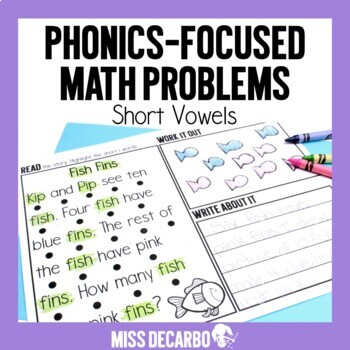Phonics Focused Math Problems Short Vowels
- PDF
What educators are saying
Also included in
- This phonics-focused math BUNDLE was created to help young mathematicians AND beginning readers practice mathematical problem-solving skills. Each set contains 20 to 25 addition and subtraction story problems that have been written to help students practice decoding skills, with a focus on specificPrice $30.00Original Price $30.00
Description
This short vowel phonics and math resource was created to help young mathematicians AND beginning readers practice mathematical problem-solving skills. Each of the 25 addition and subtraction story problems has been written to help students practice decoding skills, with a focus on short vowels. So often, our young students are capable of solving mathematical word problems, but it is the text complexity that holds them back or decreases their confidence. This resource will help students who are working on short vowels have equitable access to story problem texts on their reading level. You will love these decodable stories! Furthermore, it helps teachers integrate reading and math skills within the classroom!
Why is the format set up the way it is? It looks SO simple!
You will notice that the math problem pages are strategically set up in a simple format. Students will read the story and highlight the words that include the phonics skill. There is a simple empty box in which students can work out the problem. The work space is left blank in order to encourage students to work out the problem in any way that best suits them. Students can draw pictures, draw base-ten blocks, write number sentences, use manipulatives within the box, etc. A space for students to write about their math work is also included. As the teacher, you can use this space as you wish. For example, you may want students to write their answers in complete sentences or simply write about the process or strategies they chose to use in order to solve the problem.
Who was this resource created for?
I created this resource with first grade in mind, as the problems have sums and differences up to 20. The problems contain a mixture of addition and subtraction problems. Kindergarten students who are working on reading short vowel words will also benefit from this resource with teacher assistance. It would make a wonderful kindergarten small group activity, or a whole-group activity in which the teacher leads the class and models the problem while students work through it together. Second grade students or special education students who are still working on short vowel decoding skills, as well as word problem and mathematical problem-solving skills, will also find this beneficial.
What is included in my purchase?
- About the Resource page, Ideas for Use, Directions, Photographs
- 5 short a word problems
- 5 short e word problems
- 5 short i word problems
- 5 short o word problems
- 5 short u word problems
- ALL word problems come in TWO formats: with the numbers AND with numeral words. You may choose which differentiated version works best for your students' needs!
Can you explain why there is not a step-by-step process for students to go through as they work out the problem? For example, where is the space for the students number sentence and why was that not included?
By NOT having students follow a sequence of problem-solving steps, we encourage our students to be mathematical risk takers. This resource is designed to help beginning readers have access to the text, think critically about what each problem is truly asking of them, and use a variety of strategies to best solve each problem. I hope you and your students enjoy this resource! We want our math students to not just go through a series of rote "steps" as they solve math problems. Instead, we want them to focus on truly understanding what the question is, what pieces of information they were given and need most, and what method of problem-solving will work best for them as they find the answer. This story problem math format is designed to facilitate risk, creative and critical thinking, and problem-solving skills!
I hope you enjoy this resource! Be on the look out for MORE Phonics-Focused Math Problem packs coming soon! Be sure to follow me on Instagram to get all of the latest Miss DeCarbo news.
Christina DeCarbo-Wagers
Copyright 2021
All Rights Reserved






